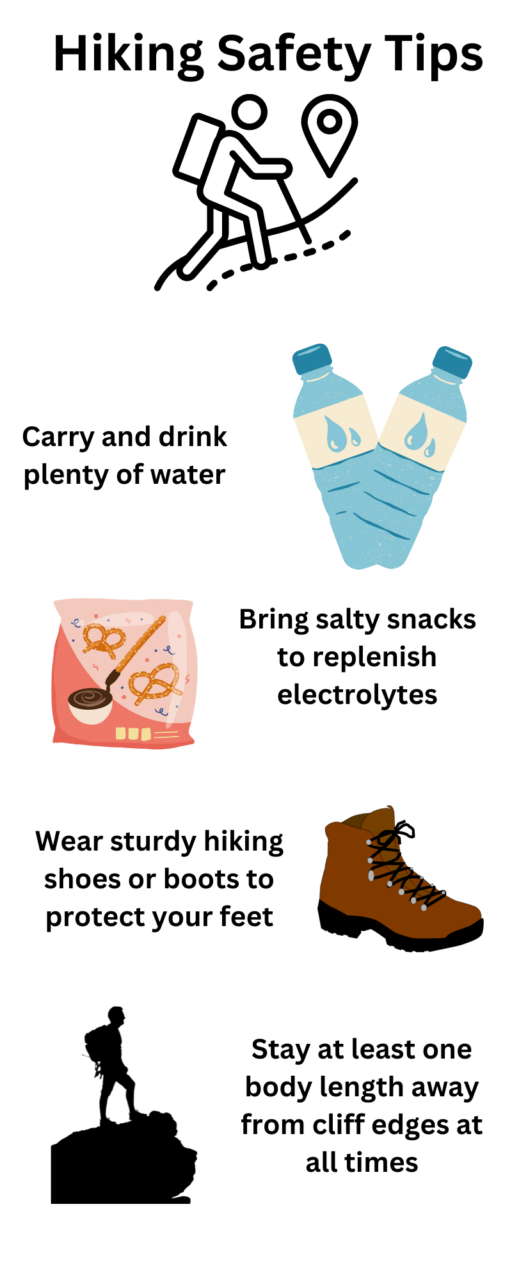Utah saw three deaths involving hikers in February and the tragedies highlight the importance of hiking safety.
Two 17-year-olds, one in Hurricane, near Zion National Park, and one in Moab, fell from cliffs while they were hiking. Additionally, a 71-year-old man from Massachusetts collapsed while hiking with his wife and son in Arches National Park. Their names have not yet been released to the public.
The National Park Service website has a section on safety for hikers in Arches National Park. According to the website, “each year, park rangers respond to hundreds of search and rescue incidents (SARs) in Arches and Canyonlands. It can take hours to locate and extract injured individuals.”
The website discusses several different risks hikers face, including heat and sun exposure, proper footwear, climbing and scrambling, lightning and flash floods and the importance of staying found. These risks are raised by the website to ensure hikers’ visits to the park are both “safe and enjoyable.”

National Park Ranger Karen Garthwait has been working for the NPS for more than 15 years. She said safety is something they take “very seriously.” The rocks along the trails might seem solid, but due to erosion and weathering, they might not always be as stable as they appear.
During the winter months, the additional risk of icy trails is added to any hiker’s experience. The NPS recommends hikers wear traction devices on their shoes during these months.
Another risk hikers face is the challenge of the hike itself. The elevation in Utah can be difficult for hikers, even when they have experience under their belt. “It’s always important to pick your activities to match your ability level,” Garthwait said.
BYU professor Mark Widmer works in BYU’s Department of Experience Design and Management, and has been teaching outdoor classes since 1990. Before becoming a teacher, he was also a professional guide for years. In Widmer’s experience, “many people have more confidence than their actual skill or ability.” If hikers push themselves beyond their own ability level, then they run the risk of hurting themselves or others.
BYU professor Brian Hill works with professor Widmer, and said “it is very important that individuals know their limits when it comes to stamina and nutrition and hydration and have a turn-around point or time so they can get back home safely.”
Hill also said hikers can occasionally become stuck in difficult situations if they run out of phone battery as night approaches. “I think many rescues could be averted if hikers would bring along a flashlight even when they don’t think they will need it.”
Widmer said hikers should have an alternative way to contact the outside world when hiking beyond a cell phone. “People have cell phones, so they think they’re safe going to these places. They think they can use the light on their phone, but it doesn’t work.”
He also encouraged hikers to use a satellite messenger and a flashlight, rather than relying on phones. By providing someone at home with the frequency of the satellite messenger, they can track the hikers live to ensure emergency responders can know where to find them in case of an accident.
“Stay a full body length away from exposure,” Widmer said, whether that involves climbing or scrambling up a cliff face from below or approaching a cliff edge from above. “It’s just a bad idea.” By being aware of their surroundings, hikers can be prepared for slippery trails, inclement weather and time spent on the trail.
Dan Christopherson, owner of 12 Finger Outdoor Adventure, has been helping guide clients through trails since 2005. Even after taking “tens of thousands” of hikers, they have never had a serious injury on the trail.
“It comes down to prior prevention, preparing yourself and the clients,” Christopherson said. He said accidents usually come from a number of bad decisions previously made. “If you catch it early, you can redirect.”
Hikers that take the time to prepare beforehand can greatly reduce the number of accidents that happen on the trail. Bringing water and food, wearing the proper gear and planning the trip beforehand can improve the odds of success and fun while being out on the trail.
According to the NPS website, hikers that are familiar with the hazards they can face on the trail will allow them to “hike safely in the park.”




